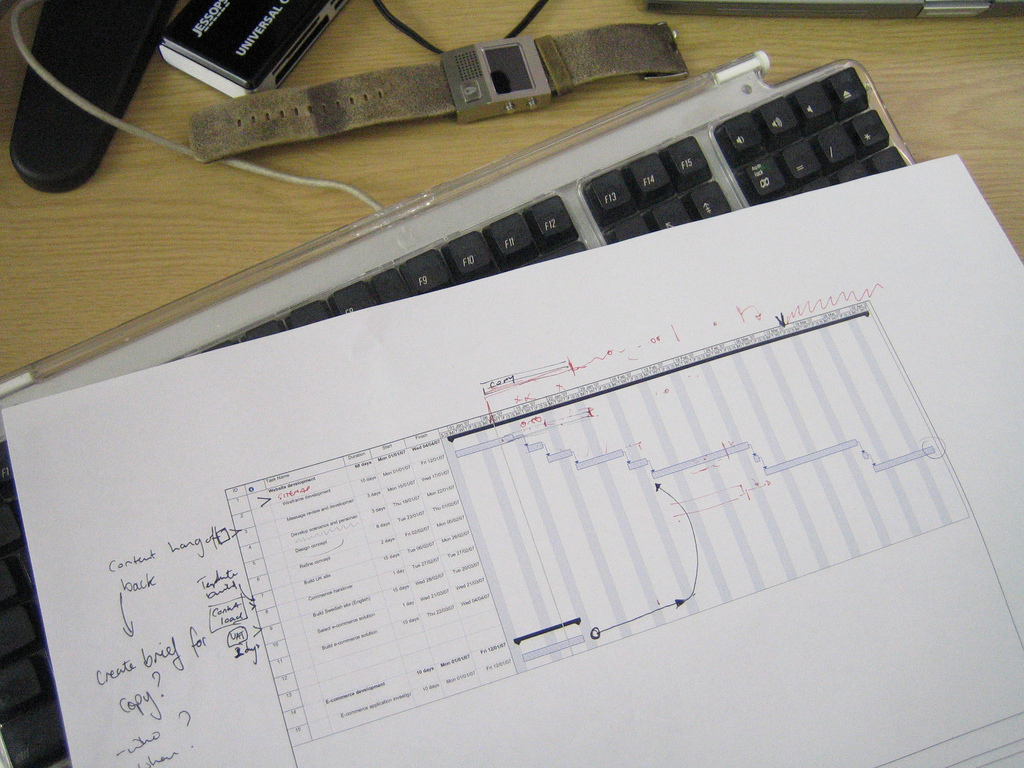Communication of accurate and timely information is one of the main keys to a successful construction project, because there are so many different parties involved and affected on each project. Think about all of the contractors, subcontractors, architects, engineers, owner’s representatives, building operators, and vendors that are involved in one project and it’s easy to understand how a lack of communication can waste a lot of time and a lot of money. The main forms of communication used on construction projects are the specifications, drawings, and schedule, and if any of those aren’t accurate, disasters can arise.
Today we’re going to focus on the scheduling aspect and the ways contractors can manipulate the actual schedule and the scheduling process to their personal benefit and how to defend against them. Amanda Jo Amadon, Emily Federico, Stephen Pitanello, and James Zack are researches and writers for the Navigant Construction Forum, and they’ve created a comprehensive, 49-page report on Construction Scheduling Games, which can be downloaded here. Navigant takes lessons learned from past construction related disputes and turns them into learning opportunities for the industry. In this post, we’re going to highlight the scheduling games contractors play as determined by Navigant’s report and give a brief summary of the defense against them. The full document is worth the read and we hope you download it. We’ve also tackled another of their reports in the past regarding the actual cost of rework, which you can read by clicking here.
Many of the solutions begin in the design phase with specification changes and clarifications, and, although this it written from the point of view of the owner, we think knowing about these scheduling games can help contractors determine when games are being played with them as well.
1. Failure to Provide a Construction Schedule
The easiest way to not be held to a schedule is to just not create a schedule. As the Navigant report points out, in situations where delay disputes arise, by not providing a schedule at all, the contractors hope that it would prevent an owner from making any delay claims against them and also give the contractor grounds to develop a schedule delay claim against the owner. In order to defend against this, the report states that a detailed scheduling specification during the design phase that describes the owner’s expectations, delaying payment until schedule has been approved by the owner, forcing the scheduling process to begin at the notice of contract award, include baseline schedule submittal as a milestone, schedule a pre-construction scheduling conference, requesting a preliminary schedule on large and complex projects, and not allowing the contractor to start work until the schedule is submitted
2. Inadequate Scheduling
While failing to provide any schedule at all is truly damaging to project success, inadequate scheduling is possibly only slightly less damaging. Without providing the owner enough information, proper business decisions cannot be made in due time and could cause delays and confusion later on. Just like the first game, Navigant suggests to include a detailed scheduling specification to explain exactly what is expected with regards to schedule detail. Other defenses include: specifying a minimum number activities to be added to the schedule, determine a maximum duration for each schedule activity, require a dedicated scheduler for the project, require that the contractor specifies the specific individuals responsible for scheduling, and require a specific scheduling software to be used.
3. Submittal Review Time
Many times, specifications include generic statements like “reasonable period of time” in order to hold one party responsible for something. The problem is, unless that period of time is specifically defined, no one can be legally bound to sticking to a specific time frame. General language such as this allows the architect and engineers to take more time to review submittals than necessary and it also allows contractors to only include a certain amount of time in their schedule and make a delay claim. Then first defense to this situation is to determine a minimum owner/engineer review time in the contract. Concurrently, the time frame for re-submittal review time should also be defined.
4. Failure to Show Submittal Review
As discussed above, not including a definition of submittal review time allows the contractor to add however many days to the contract. Sometimes, contractors write schedules where submittals shall be submitted and approved on the same day, which then sets the contractor up for a delay claim. To combat this game, submittal reviews should be incorporated into the schedule and clearly labeled and the contractor can be required to submit a schedule of when they believe each submittal will be submitted for review.
5. Delivery Dates for Owner Furnished Equipment of Materials
On a lot of projects, the owner will pay for and order necessary fixtures, material and equipment. Obviously, a contractor cannot be held responsible for the owner failing to provide the items at the appropriate time. Knowing this, sometimes contractors will show unrealistic delivery dates on the schedule that the owner cannot meet to set up a future delay claim. Declaring a “Not Earlier Than Delivery Date” for owner furnished projects can help an owner avoid this situation, as can specifying a schedule window for deliveries.
6. Failure to Show Procurement Activities
In this scenario, a contractor includes installation of an owner furnished item on the schedule, but fails to include the preceding activities that allow that installation to take place, such as submittal preparation and review, fabrication, and lead time. The designer should prevent this scenario from happening by determining the length of time it will take to complete those preceding activities up front so that no confusion happens. A separate equipment procurement schedule can also be created by the contractor to communicate to the owner their expectations of when the items will be available for installation.
7. Failure to Include Contract Schedule Constraints
Schedule constraints happen more often in remodel projects mostly in the form of phase plan or restricted times for construction activities. The purpose is to allow the uninterrupted use of certain areas of a building while construction is taking place. If these constraints are not clearly stated by the owner before the schedule is created, problems will arise with delays and progress, so the first defense is to put these constraints into the specifications. Interim Milestone dates should be communicated by the owner and they should also carefully review the schedule to be sure that these constraints have been accurate portrayed in the schedule.
8. Phony Early Completion Schedules
Early completion schedules, also known as Ghost Schedules, are parallel schedules created by a contractor in order to either try to force its subcontractors to complete the job early or to try to establish a delay claim. Owners need to determine a realistic period of completion for their project before the project is bid. Other methods of defense include: adding a “joint ownership of float” clause to the contract that specifies that both the owner and the contractor are able to use float days, adding a “reduction of contract duration” clause which allows the owner to use the contractor’s early completion schedule at no cost to them, or adding a clause that allows the owner to obtain a credit for overhead costs due to a contractor’s early completion.
9. Preferential Logic
If a contractor improperly sequences a project “in a manner as to create the maximum possible opportunity for owner interference”, this is known as preferential logic. Contractors may use this tactic to request a project extension whenever the owner asks for a change of the schedule. A thorough review of the schedule and regular schedule updates are in order to combat this situation
10. Sequestering of Float
If float days are allowed in the contract, the contractor may try to sneak float days within the schedule, therefore forcing a delay every time the owner asks for a change. Sequestering of float days can happen due to preferential sequencing and artificially adding extra days to certain activities. IN this situation, Navigant suggests that the owner thoroughly review the schedule and schedule updates, require subcontractor participation in scheduling, adding a “non-sequestering of float” clause, and to specify that all schedule activities be loaded with resources such as manpower and costs.
11. Failure to Include Start-Up/Testing Activities
Many projects require that the contractor start-up and test equipment for malfunction at the end of the project, but sometimes the actual length of time it takes to do so is grossly underestimated. In order to keep all party’s expectations clear, the owner should estimate the time it will take to perform all of the start-up and testing activities.
12. No Schedule Updates
As with both the no schedule and inadequate scenarios (#1 and #2), not updating the schedule regularly will cause similar project failure. Some specifications are worded with a statement such as “the schedule shall be updated when a major change occurs”, but a “major change” is not properly defined. Other than clearly defining when schedule updates should occur, the owner can also add a specification that allows them to only pay the contractor when items are approved to have been added to the schedule, add a “pay off the schedule” specification that assigns a percentage to the work completed, add a liquidated damages clause that penalizes the contractor for not turning in an update on time, and withholding the payment for failure to update the schedule.
13. Inaccurate Schedule Updates or Inaccurate As-built Information
Inaccurate schedule updates is another tactic used to absorb schedule float days without needing to, whether by saying a task started earlier or ended later than it actually did. The same defenses used in the “sequestering of float” game above should be used here.
14. Inaccurate Schedule Updates- Scheduling Away Project Delay
In this scenario, a contractor, who is actually showing to be behind schedule, will reduce durations of future tasks as to not show a delay on its project completion date. Again, a thorough review of the schedule updates should suffice in combating this practice.
15. Changing Project History
While Navigant admits this is a rare scheduling game to play, it has happened that contractors will change dates of previously completed tasks as another way of consuming schedule float.
16. Changing Project Calendars
Current scheduling software can allow the user to change the project calendar each time the schedule is updated. The intended purpose of this option is to allow for daily and hourly scheduling of separate trades, but it can lead to instances where schedule float is slowly absorbed, even though no float days have been used. To catch such occurrences when they happen the owner should spot check every schedule update for changes, schedule monthly meetings with the contractor to jointly update the schedule, add a clause to the specifications that requires a schedule update each time a new activity is added, request an electronic version of the updated schedule, or require weekly progress reports from the contractor.
17. Failure to Incorporate Change Orders into Schedule Updates
Change orders happen and many times they aren’t included into schedule updates, which allow contractors to determine just how much the change will affect their schedule at the most opportune time. Adding a clause to the contract that requires a time impact analysis each time a change order is submitted is one way to combat a delay claim later on. To further entice contractors to actually complete this analysis, the owner can offer a set fee that the contractor can add to the change order.
18. After the Job “But For” Schedules
A “but for” schedule is a merger of an as-planned schedule and an as-built schedule. Typically, these schedules are created by a claims consultant in order to try to claim a project delay, which can result in costly schedule analysis to the owner. The “single most effective defense” against this, as the Navigant report states, is to add a clause to the contract that requires an as-built schedule to be completed before the retainage is released.
19. Substantial Completion Activity
The final scheduling game that Navigant explores is the exploitation of the vague definition of “substantial completion.” Liquidated damages stop when the project has reached substantial completion, so the contractor clearly has benefit to claim it as soon as possible when the situation arises and they would be right to do so. A clear definition of the term is perhaps the only way to combat such instances in the future.
Schedule Review Checklist
Though that completes the 19 scheduling games that contractors can play, Navigant also provided a great checklist for reviewing the schedule that we hope will give you incentive to download their report. It touches on all of the things to check for regarding software settings, dates, activities, constraints, and calendars.
Construction Scheduling Games – Revisited & Updated | Navigant Construction Forum












